Affirmation: the Morning Star
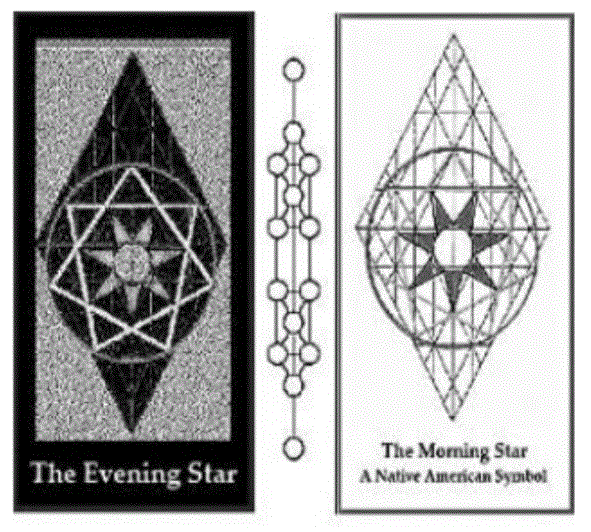
As a two-dimensional statement, the Crown Diamond demonstrates the unity responsible for such things as Platonic solids. The diagram maps the mathematics of creation. It therefore represents the logic operative in creative forces, which are Elohim myhla, the tools of the godhead. The parables of holy writ are keys to the spiritual operations of creation’s structure within the individual and society at large.
Geometry is a universal language upon which creed has little influence. Resisting discussion of connections to any particular religion, modern-day practitioners of the discipline of sacred geometry explore the properties of its logic, whose key is hidden in the two-dimensional illustration known as Metatron’s Cube, which is represented in the drawing called the Vitruvian Man, credited to Leonardo da Vinci.
What is true in two-dimensional thought cannot rightly become false in multidimensional thought. The simple points to the complex because the complex affirms and augments the simple. What is seen in two dimensions, therefore, can be imposed upon other dimensions without error, if the two-dimensional understanding is accurate.
As mystical writings, the scriptures affirm the systems developed by mystics from the beginning. Biblical truth affirms, unifies, codifies, and augments the faces of truth behind all religious thought. In the creation of HaShem is not yes and no, but yes as that which is thought to be in error is properly understood.
Discussion of what makes the geometry “sacred” is rather thin, but among its themes is discussion of the mathematical ratios that unfold in the dynamics of the flower of life, which is intrinsic to the pattern of creation. The key to these dynamics is hidden within Torah as the measurements of Noah’s Ark.
 The measurements of the Ark are the
bones of the Crown Diamond of the believers’ Tree of Life. Expressed as
cubits, the salient aspect of the fabled Ark is that its length is six
times its width, which establishes the optimum shape for the symbol
called Adam Kadmon, the “Projection of Man.”
The measurements of the Ark are the
bones of the Crown Diamond of the believers’ Tree of Life. Expressed as
cubits, the salient aspect of the fabled Ark is that its length is six
times its width, which establishes the optimum shape for the symbol
called Adam Kadmon, the “Projection of Man.” Widely recognized as the symbol of the Tree of Life before the appearance of the Crown Diamond, representations of Adam Kadmon were drawn in various dimensions. When the symbol of the Tree of Life is drawn in congruence with the ratios of Noah’s Ark, however, four interlocking Adam Kadmon diagrams are generated, each positioning atop the others. This sacred geometry is illustrated on this website.
The Ark’s ratios speak of the geometry displayed within creation, in general, and of its harmonics within the humanity, in particular, because its measurements affirm the name Adam Kadmon as sobriquet for the symbol called the Tree of Life. My sense is that the Projection of Man was entrusted to the sons of Peleg, whose migrations covered the earth.
You might assume I’ve spent a good deal of time with such analysis, but that is not the case. The Crown Diamond display came by revelation. I had no knowledge of these mysteries; and I didn’t learn of these ratios through the disciplines of kabbalah. They came subsequent to a spiritual ordination.
No doubt some will hold that I don’t know what I’m talking about, and I cannot disagree. Eventually, however, I dabbled in the study of many things, but my guide for study was always mycdq cdq, the holy spirit.
I had no hunger for fame or notoriety; and I wonder at what’s been done in me. I wrote of the revelation in a book of testimony, which is available as a free download at crowndiamond.org. Its title is The Crown Diamond of the Believers’ Tree of Life: the Measurement of the Tabernacle of David. I would not fabricate such a title. I did the work of a scribe.
It wasn’t necessary for me to dive into literature to do those things given into my hands. The father provided me with two very accomplished brothers who shared their knowledge: Shmuel Wahli-Aharon, who introduced me to Paleo; and Michael J. Murphy, who introduced me to kabbalah.
Eric J. Wilkens helped with these illustrations, and he shared a book in which the Morning Star of Native American shamanism was depicted. Eric has passed on, and I don’t know the name of the book he shared. I’ve not found another source for this fullest version of the Morning Star, and the Sioux Nation hasn’t answered my inquiries. The parallels were evident to me, but I assume its origins are separate from the sacred geometry of the West.
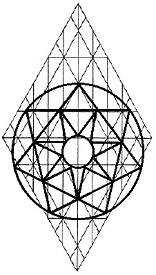 My conclusions travel a firmament of bald belief; but lack of
supportive reference doesn’t make them untrue, though my view asks much
of my readers. In any case, the harmony between the Morning Star and the
Crown Diamond is the result of shared mathematics. With such difference
between Western cultures and the culture of native Americans, I was
amazed to find unmistakable correlation.
My conclusions travel a firmament of bald belief; but lack of
supportive reference doesn’t make them untrue, though my view asks much
of my readers. In any case, the harmony between the Morning Star and the
Crown Diamond is the result of shared mathematics. With such difference
between Western cultures and the culture of native Americans, I was
amazed to find unmistakable correlation. That the symbols share features which make the geometry close might be coincidental, discounting the precision. However, the prophecies associated with the geometries are also close, which makes them sacred.
Despite the excesses and abominations of the European invasion of the western hemisphere, natives of the West foresaw a time of restoration, during which the Great Spirit would intervene to heal Mother Earth, refreshing the spirits of its peoples.
John the revelator also foresaw a time when earth would be healed and Truth would triumph over falsehood. The statement in Revelation, “I will give you the morning star,” is open to interpretation, but both shaman and prophet foresaw restoration.
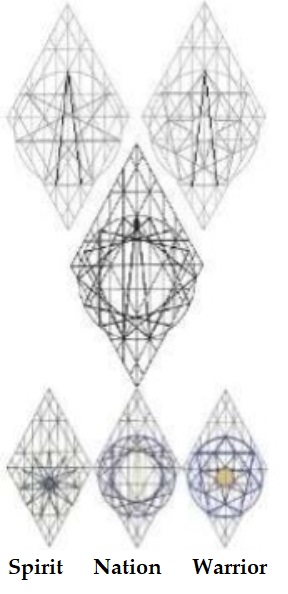 Within
the Crown Diamond system of diagrams, the Native-American star appears
by marking the firmaments that extend from Laodicea to the two expanses
at Pergamos, and then circumscribing the angle that’s formed.
Within
the Crown Diamond system of diagrams, the Native-American star appears
by marking the firmaments that extend from Laodicea to the two expanses
at Pergamos, and then circumscribing the angle that’s formed. By laying the width of the vertical Tree of Life end-to-end around the rim of the circle, fourteen points are established. The Morning Star has only seven points, but doubling the Life Tree’s width reduces the points along the circle to seven. From there, the Morning Star is completed by connecting the dots in a logical manner.
Having only minimal contact with Western civilizations, so far as we know, American shamans were able to identify and codify logic that is congruent with, but separate from, the logic expressed in scriptures.
As the planet Venus, the morning star is an expanse that travels in concert with the expanse of earth around the expanse of the sun. Shared firmaments are common in the mathematics of creation. The Native American symbol finds its voice in the restored diagrams of the West.
Like Venus, however, it follows its own path. It is very significant that these diagrams, at this time in history, share dramatic congruence in concert with tribal prophecies of restoration and the promises of the book of Revelation.
The Morning Star is given to those who overcome in Thyatira, the “church” that corresponds to the
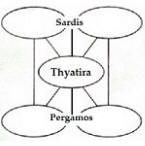 kabbalist
“brightness” called Tipareth, the chakra
known as Anahata in the East. A powerful center within the human
organism as projected from the third heaven, Thyatira marks the position
of heaven’s throne, above which the voice of HaShem is heard. Within
scripture’s Kingdom of Names, Thyatira is the seat of many weighty
parables.
kabbalist
“brightness” called Tipareth, the chakra
known as Anahata in the East. A powerful center within the human
organism as projected from the third heaven, Thyatira marks the position
of heaven’s throne, above which the voice of HaShem is heard. Within
scripture’s Kingdom of Names, Thyatira is the seat of many weighty
parables.A church of dynamics, the court that surrounds Tipareth suggests a cross, of sorts, but one whose arms and legs are unbound. Rendered into English as “Beauty,” the court at Thyatira no longer speaks of sacrifice, but of power.
Tipareth is the administrative seat of HaMashiyach Yahushua. As seen in this illustration, the cross of Golgotha that is suggested by the three churches at Ephesus, Smyrna, and Pergamos, gives way to the cross of resurrection.

No longer the hidden messiah, ImmanuAL appears in his strength at Thyatira and interacts with the Sons of Man. Openly knocking upon numerous chakras as Yahushua HaMashiyach, the Angel of the Presence, invites all who answer his knock to take up his yoke, and follow, that they might work together within the Kingdom of Names.
That Messiah pledges to give the Morning Star to those who overcome the dark issues of the heart chakra is very much like a proposal. Forming familial bonds, the called and the chosen will labor together through the harvest time, earning wages with which to purchase such items as the great wedding feast will require.
As ministers in the room of messiah, we receive the counsel of HaShem. We are awarded perceptions tailored to fit what each of us needs to rise higher. Progressing together, we will find ourselves positioned as expedience demands, in a ditch or on a pew.
 Smyrna occupies the chakra at
Swadhisthana. In kabbalah, that sphere is called Yesod, which is
interpreted to mean “foundation.” In terms of the physical body, Smyrna
is the parable of the digestive tract, whose faculties supply the body
with energy and stamina. In Smyrna, duality begins to manifest itself as
the waters of the spiritual world interact with those of the physical
world.
Smyrna occupies the chakra at
Swadhisthana. In kabbalah, that sphere is called Yesod, which is
interpreted to mean “foundation.” In terms of the physical body, Smyrna
is the parable of the digestive tract, whose faculties supply the body
with energy and stamina. In Smyrna, duality begins to manifest itself as
the waters of the spiritual world interact with those of the physical
world. To overcome in Smyrna is to grow in faith, believing that you have been invested with the ability to give true witness of your experience without contradicting your nature, without offending others, and without making apology for your faith.
More, you grow because you understand that you are not alone; for in the processes of growth, the experience of working in concert with HaShem has convinced you that his guidance is more than sufficient.
Beyond the blessings that will accompany your remaining days on earth, you will be rewarded with leniency against the day you will be required to surrender the mortal soul for judgment shall come upon you. Secure in HaShem’s mercy, you are ready to move forward as called, embracing your progress on the path to perfection.
Smyrna is foundational. Beyond its gate are the three paths that lead to Golgotha. The expanses of earth are a jumble of spiritual battlefields. To make headway in one is to be in danger of losing ground in another as cause engages its effects, all of which are transformed into causes that generate yet other effects.
The subtle shifts in moving forward are both reward and distraction; and to focus on any particular instant is to lose sight of the whole. Plant your feet wide and prepare to stand your ground until guided from above; for it is not for man to direct his steps.
The dynamics that overtake at Pergamos are potent; for it is a sanctuary that can be compared to Manipura of the East. This is the lair of the dragon, the prince of the power of the air.
The dragon builds his nest over a treasure trove and arises only to head off and kill intruders who come near to what he holds dear. Each of us has emotional treasures that are nested within our hearts. If another approaches and threatens their safe keeping, we arise: prepared to battle to the death, if necessary, to defend what we see as our own.
What is true on a personal scale is also true on a communal scale. Society consists of groupings of individuals, who nest within areas of shared interest and shared opinion. When those hoards are threatened, members of the group react as one to nullify the threat. In this respect, Pergamos reflects the war between individualist thought and conformist thought: between the conscious mind and the subconscious mind.
Pergamos is complication, and many things happen there, all at once. It is immersion in duality and the tug-of-war that follows. In the careful contest between honor and splendor, you will be drawn to a friend, only to discover that he is an enemy; or to an enemy who is, truly, your friend. Nothing is as it seems because theater of the conflict is the mind, and the issues can be written off as imagination.
To expand and expend, you must consume. You will make use of substances and will expel that which poisons you and those things that are superfluous. To our minds, breathing is a simple matter: we breathe in the good air and expel the bad air. That the air we breathe is fundamentally altered in the process doesn’t come to mind, nor do we much care. It’s the fresh breath we’re after, the newness, the treasure of life.
Pergamos is Golgotha. There is a way of escape. As we behold the struggle between the immortal and the mortal spheres within the temporal realm, we forget that both are projections of the eternal realm. Our battle there is finished when we recall memory of our first love, drawing upon that strength.
We are not alone. We are not comfortless. Greater is he that is with us those who conspire against us. With every challenge, there is a way of escape; and if we fall, we can rise again. We can find comfort in the yoke of the charioteer, which is the angelic womb. There is pleasure in his reins of spirit, by which we are guided through the maze of our lives. Fear not. All things are lawfully given into our hands, if we can accept and receive.
Dealing with expanses is always complex and problematic. A detail will be ignored or overlooked as the inward struggles go on, complicating resolution. A solution will come to mind and be shouted down by the crowd when we try to share it. To waste time worrying about dropped thoughts or a missed opportunities is to distance yourself from the reward of faith.
Faith is not a trinket to be enjoyed, then cast aside. It is the gift of the eternal Name. Just as we can do nothing to earn that gift, we have no power to cast it, forever, aside. HaShem knows how to give good gifts to his children and how to restore the fruits of his will in us.
If we seem to have lost faith, it’s not because it’s lost, but because it’s been hidden, for God’s good reason. When it is once again called to mind, it will have been reinforced by the addition of much detail: strengthened beyond comprehension. We will awaken as dreamers, and we will walk many days growing into the garments of our new mornings.
By the agency of HaMashiyach, HaShem is pilot of our thoughts as we labor, together with all the holy angels, on behalf of the Kingdom of Names. Let us be still, and believe. A way forward will appear.
There is a reason I didn’t chase after this kind of knowledge when the Crown Diamond vision came. The scripture is clear: it’s HaShem’s role to drive out offensive elements, replacing them with the blessings he holds in store for us.
In messiah, we entered into a covenant, an agreement; and the duty of the savior is to show the saved the way he is to go, providing him with the means to follow his counsel. Our duty is to listen, to hear, to obey if we understand; and if we do not understand—if we are not able to follow counsel—it is our duty to speak up; for the answer we receive will both enlighten us and strengthen our faith.
The heavenly father is our savior: not we, ourselves. Our job is to hold our peace and to wait upon his counsel by the utterance of his projection. We have been given the tools of reason and are able to discern between cattle and cattle, which enables us to function; but we are not to judge, nor can we set the pace. In a convenient time, HaShem will answer.
If it is I who must determine the way I should go; if it is I who must decide whether an element within my being can remain; if it is I who must decide whether and to what extent a judgment should be levied against another; if it is I who must do these things, I have strayed into the hands of the Baalim, the false shepherds.
Deluded, I’m on the dangerous ground of sands that shift beneath the winds of doctrine; and a loose thought will strand me in consternation astraddle Balak’s mule as I ready myself to accuse the brethren, pointing my finger over concerns that are unsettled within my own heart.
If it is a convenient time for a thing to go or to be embraced and I am enabled to allow HaShem to make it happen, I will remain clean, even as I am cleansed. Allowing HaShem to fight for me while I hold my peace, I will be clothed in the garment of righteousness, not the black robes of the zealous inquisitor I would surely become if left to my own devices.
Ten nations—ten cohesive spiritual dynamics, not ten clusters of people— were to be driven out of Canaan with the advent of Y’SharAL of the Kingdom of Names; but three became subservient to Y’SharAL.
The battles at Pergamos, like the wars between nations, are begun within the fields of conversation; for the power of life and death rests upon the tongue, which utilizes the air within the lungs to launch hostilities or to sue for peace.
Coming to our senses at Pergamos, we can avoid the right- and left-hand paths by moving directly forward into Thyatira. In doing so, we demonstrate fidelity to our first love. The predominant teaching of the New Testament, love points to the teachings of Anahata of the East, and to “Beauty,” which is an apt translation of Kabbalah's “Tipareth.”
To overcome at Thyatira is to discover the root of spiritual strength that hides within the body: ImmanuAL—God with us, among us. Always with us, he accompanied our spirits when we came to earth, and he will enable us to withstand the calumny with which others might revile our beliefs.
Such attacks are without spiritual power unless we cede it to the oppressors out of fear or because of ignorance. With no spiritual power of their own, they must find and exploit every weakness they can discover because they thrive on fear.
If they think they know something of which you know nothing, they will marshal that supposition into weaponry, not argument; for they have no interest in what you think or believe. They monitor weakness not out of concern, but because it fuels their attacks.
Take refuge in spiritual knowledge, which is born out of love, not reason. Empathy is seductive. Draw upon the righteous mammon born of Wisdom; for it will make brothers of us all.
Whether sinner or saint, those whose diets consist of intellectual knowledge are prisoners in their own bodies. Like eagles, their minds scan low places, looking for possibilities, vulnerabilities. They need to attack inferiority to prove their worth.
Unless Truth sets you free of reliance on accurate data, you will fall prey to their devices and stumble under the weight of their attacks. You must forgive them; for they know not what they do.
You will understand that adversaries confess the poverty of the natural mind because they have no treasures within their hearts. Forgiveness is not an option, but a necessity. It’s not an act of will. It’s the fruit of compassion. Shielded in love, you will no longer be baited by the tone or the substance of any challenge.
When love drives conversation, words aren’t easily turned into argument; for they will have been delivered from the heart of a healer who speaks Truth, not from the mind of an opponent ready for a fight.
Follow peace with all men. The more one quarrels, the deeper the hole he digs. Think carefully before reaching for a shovel, because holding your peace will have greater effect on an adversary’s thoughts than argument ever could. When an adversary becomes a friend, much has been accomplished.
In the Church at Sardis beyond Thyatira, the stakes are raised, and not by you. HaMashiyach confesses your Name before the father; for you are beloved.
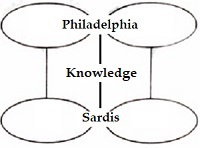 You worry that you have not been perfected. Such thought wars against
faith. Days of doubt and denial have an end. The human condition is
peculiar to humans, and it’s not unforgivable that you should seek
warmth in Pilate’s kitchen. Simon Peter took comfort: he had been
forewarned, and still he had failed; but the master trusted him, still.
Be still! Hold your peace. It’s a merciful God’s good pleasure to
embrace you within the Kingdom of Names.
You worry that you have not been perfected. Such thought wars against
faith. Days of doubt and denial have an end. The human condition is
peculiar to humans, and it’s not unforgivable that you should seek
warmth in Pilate’s kitchen. Simon Peter took comfort: he had been
forewarned, and still he had failed; but the master trusted him, still.
Be still! Hold your peace. It’s a merciful God’s good pleasure to
embrace you within the Kingdom of Names. You are being lifted upon the rungs of Jacob’s Ladder, and your spirit is resting on the fifth rung, whose end points are the expanses of Din (Judgment) and Chesed (Love). Din is also called Gevurah, which is suggestive of the ethical judgments men execute, one against another—the value judgments.
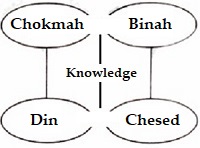 These expanses of
the fifth rung of Jacob’s Ladder correspond to the chakra known as
Vishudha in the East. It speaks of purity, not of perfection. The heave
offerings of Torah are motivated by love, which is adorned in the
trappings of purity. HaMashiyach lifts you up as a love offering before
HaShem.
These expanses of
the fifth rung of Jacob’s Ladder correspond to the chakra known as
Vishudha in the East. It speaks of purity, not of perfection. The heave
offerings of Torah are motivated by love, which is adorned in the
trappings of purity. HaMashiyach lifts you up as a love offering before
HaShem. Were it not for hope of that love, you would be undone; and in desolation, you would flee every focus in search of oblivion; for each moment will have become an empty agony. You take solace in solitude, so that none might see your shame.
Not only will it disarm your adversaries, God’s love in you will overcome your fear of the Infinite, and you will discover that you are prepared to complete the stations of the cross. Worship HaShem as you pass through the Churches of Asia. It’s the father’s pleasure that you advance.
You will be known by your angel’s unique Name, and that Name will not be blotted out of the Book of Life. It is secured, not because of anything you have done or might yet do, but because of the integrity of the Name hwhy and because of those who traveled this path before you, tending the gardens within the Kingdom of Names.
There’s an empty room within the Tree of Life that has never been occupied by man. It hides just beyond the star in the angel’s right hand. The sphere of knowledge belongs to the Vine, and it answers to Yahushua.
Not all can perceive it; for it rests among and within the branches of creation’s Tree of Life. It’s grapes are the Logos, and neither father nor son is pleased if their teeth are set on edge by its unripened fruit. In the time of its harvest, its savor will be pleasant; its fruit, good.
If you followed the wild theorems of science, you may have been struck by the tactics devised to unearth proof of the quark—that illusive, smallest component of matter. Massive centrifuges were constructed and buried underground, so that small bits of very small bits of atoms could be sent hurtling around the globe, to the end that their minuscule masses would collide, breaking them into ever-tinier bits.
Sparing no expense, technicians exhausted every strategy without finding that smallest something, although they have been cagey about their findings. Hedging their bets, they tentatively distanced themselves from the quark.
To explain our existence, they were presently exploring a hypothesis called string theory, last I heard. I know next to nothing and understand less, I’m sure. Unless I’m mistaken, the theory posits that a shudder, of sorts, ran along a virtually mass-free current, causing vibrations that— aha! Well...maybe, anyway!
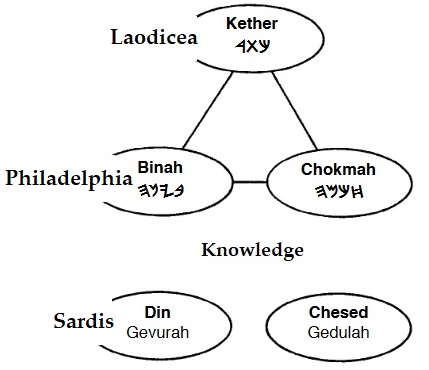 I’m suddenly closer to verbalizing the nominal reason I’ve written
all these words, but there’s rummaging still to be done before I can
properly launch the firmament of this expanse in good conscience. At the
beginning of these narratives, I warned that I might not be able to get
there; but my guess is we’re not that far off. I must admit, however: a
mass-free charge worries me.
I’m suddenly closer to verbalizing the nominal reason I’ve written
all these words, but there’s rummaging still to be done before I can
properly launch the firmament of this expanse in good conscience. At the
beginning of these narratives, I warned that I might not be able to get
there; but my guess is we’re not that far off. I must admit, however: a
mass-free charge worries me. In the Churches of Asia, we are lifted up before the father at Philadelphia, the church of brotherly love. As Y’shua impressed upon us, we shall know we’re his disciples: if we have love, one for another.
Whether or not we are prepared to be lifted up is determined at Sardis, for the name “Gevurah” arises there, questioning our values. In Gevurah, the rigors of Din are offset by the mercy that emanates from Chesed. As we are lifted up, we suffer judgment only if we bring judgment on ourselves by leveling accusations.
Accusations are lethal stones; and those we throw skip along the surface of the waters, coming back around and landing on our own heads. To stand in violation of any single point of the law of HaShem is to stand in violation of in every point. Perfection is not likely where imperfection persists.
Willful violation of the law is not common behavior. Most error is inadvertent, and accidental offense may be possible. To play the lawyer after the fact is to hand iniquity a short-term victory; for the god such argument serves is behavior.
Where there is no accusation there is no offense and, therefore, no judgment. In the narrative of the discovery of iniquity in the Light Bearer, the error is presented as a fait accompli: iniquity was not there until it was; and its discovery was an unexpected surprise.
This could only mean that the covering cherub operated with autonomy, and that the spirit of the eternal one had withdrawn from creation for rest, returning to the surprising uproar made possible by his absence.
The judgment of HaMashiyach is true because he lives and dies within every being at every moment. Therefore, he fully understands every nuance opposing lawyers might raise to litigate to the contrary.
As creatures, we are ransomed by the sacrifice HaMashiyach makes in the moments of our lives; and as Sons of Man, we are saved by the life he lives within and among us at every instant. His love temporizes his judgment, and therefore his behavior, both of which are glorified by unending reality of his mercy.
The promises within the message to the Church at Philadelphia speak for themselves. Philadelphia is the rung of Jacob’s Ladder whose end points are the expanses of Binah and Chokmah. Binah is Understanding, which is represented in the Language of Light by the o ayin. Its cousin in Sinaitic Hebrew is the emblem f tet.
The understanding o found within the church at Philadelphia is subjective, not objective. One has understanding, whether or not it is technically correct.
Understandings represented by tet f aren’t limited either, but the symbol suggests thorough measurement that can be hammered out by the tools of logic and the gifts of inspiration. The understandings of tet f are reached through resolution of opposing considerations.
In like fashion, the Wisdom (c shin) at Binah differs from the wisdom of its cousin mem. Mem m is the reflection of shin c within creation—that is to say that m mem speaks of Wisdom’s attributes [ c+) = m ] as they are revealed and perceived in the things that are made. Like the natural woman, the waters of
mem m seek the lowest point because that depth will yield the fullest understanding. The mem m dissolves what its waters hold, even as the tet f can resolve and integrate implications f, yielding moments in which we understand o the counsel m of infinite Wisdom c. Thus, the c shin speaks of limitless Wisdom c, which is found only in the counsel m of The Shem mc Name.
In the East, Philadelphia is called Ajna. It’s associated with the third eye, the mind’s eye, which appears behind the ocular eyes, giving us the ability to envision that which is seen.
By Ajna, the mind interprets the data conveyed by the faculty of sight. Some think of the eye behind the eye as intuition, and that is correct so long as it is seen as a gift, not a skill.
When the data provided by the faculty of sight are examined with our deepest understandings, they are not driven by knowledge, but by the search for knowledge. The higher and lower understandings of Ajna celebrate each other. They are one.
Only the blind see without sin because they have an inkling of knowing how poorly they can see. At Philadelphia, we are lifted by our great love for others, which is the greatest of victories for mortals.
Those who overcome receive a new name that neither man nor angel knows; and the name will be paired with knowledge of the new name that King Messiah will shares his own, but privately.
We will understand that messiah has many names. There is no room for pride or jealousy; for the name given each of us is ours exclusively. There will be no subterfuge in greeting.
New names mean new identities. Immortal angels incarnate to overcome the pitfalls of identity. Iniquity targets identity, not the being itself. The covering cherub was not destroyed. He was appointed to another order of service. The new name signifies that the angel is ready to receive the celestial body and soul. When that which is perfect is come, the imperfect is left behind. Life in the everlasting realm would lack meaning without identity.
Laodicea, the last of the seven Churches of Asia, is equivalent to the first kabbalist sphere, which is called Kether, the Supreme Crown. Within the creature, Kether is understood as intelligence. In that it is first, the elders acknowledge that it is retrieved from a yet higher realm, which is called the Ein Sof.
This is the well of infinity, from which all things that are manifested in any way are drawn. It is unknowable to such as we now are, but will become known by those who overcome.
In like fashion, the messages to the Churches of Asia flatly state that there’s a temple level of which we are told little, but into which we can pass at the end of our journeys in heaven and on earth. In the East, that place is called Sahasrara; and at this point, the unavoidable happens: there’s general disagreement at all quarters that is difficult to reconcile.
Some see this chakra as inside the body; others, as outside. Views and perceptions vary as sentient life goes on. There’s no point in arguing. Ein Sof is out of this world.